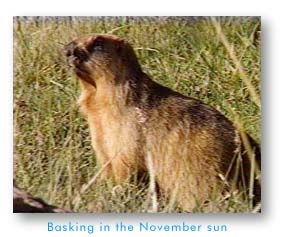Karamjeet Singh's Himalayan Home


In the high alpine meadows between ten and fourteen thousand feet, are found the Himalayan Marmots. About
the size of a large housecat, they live colonially and are fairly thick on the ground in the Upper Suru valley,
from Ringdom Gompa, all the way across the Pensi pass and into Zanskar. We
came up with some Snow Leopard pug marks in the same area - plump marmot must be an important part of his
diet..
There are 14 marmot species in the world, in fact the Vancouver Island Marmot is the
rarest mammal in the North Americas. Most marmots live in mountainous habitats - the
marmots' scientific name means "mountain mouse".
Arctomys himalayanus or the Himalayan Marmot is a distinct species, although it is closely related to the
woodchuck, the hoary marmot and the yellow-bellied marmot. The Himalayan marmot is distinguished from other marmot species by its dark chocolate-brown coat with contrasting yellow patches on the face and
chest
other marmot species by its dark chocolate-brown coat with contrasting yellow patches on the face and
chest
 Marmots live in small groups called colonies, consisting of an adult male, a couple of
adult females, some sub-adults ("teenagers"), and pups
Marmots live in small groups called colonies, consisting of an adult male, a couple of
adult females, some sub-adults ("teenagers"), and pups
Their homes have intricate underground burrows including rest areas, hibernation chambers, and a "bathroom"
Marmots hibernate for about seven months, beginning in late September and emerging in early May
Adults mate underground in the spring, and produce an average litter of three pups that first emerge in early July
average litter of three pups that first emerge in early July
Plant-eaters, they have large beaver-like incisor teeth for cutting vegetation. They eat
grasses and flowering plants

Marmots communicate by physical contact and vocally by whistling. Their most frequent
call is a high-pitched whistle, warning colony members of danger. Hence, their nickname,
"whistle pig".
Marmots adapt to non-threatening human activities and can become fairly tame and
approachable. For experienced hikers they are wonderful to photograph.


This page hosted by
 Get your own Free Home Page
Get your own Free Home Page
Web Page Design and Images Copyrightę: Karamjeet Singh



 other marmot species by its dark chocolate-brown coat with contrasting yellow patches on the face and
chest
other marmot species by its dark chocolate-brown coat with contrasting yellow patches on the face and
chest Marmots live in small groups called colonies, consisting of an adult male, a couple of
adult females, some sub-adults ("teenagers"), and pups
Marmots live in small groups called colonies, consisting of an adult male, a couple of
adult females, some sub-adults ("teenagers"), and pups average litter of three pups that first emerge in early July
average litter of three pups that first emerge in early July

